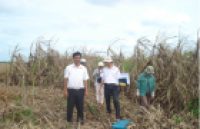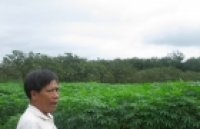| Nanomaterial Size and Surface Modification Mediate Disease Resistance Activation in Cucumber ( Cucumis sativus) |
|
Crop disease represents a serious and increasing threat to global food security. Lanthanum oxide nanomaterials (La2O3 NMs) with different sizes (10 and 20 nm) and surface modifications (citrate, polyvinylpyrrolidone [PVP], and poly(ethylene glycol)) were investigated for their control of the fungal pathogen Fusarium oxysporum (Schl.) f. sp cucumerinum Owen on six-week-old cucumber (Cucumis sativus) in soil. |
|
Xing Luo, Zhenyu Wang, Chuanxi Wang, Le Yue, Mengna Tao, Wade H Elmer, Jason C White, Xuesong Cao, Baoshan Xing ACS Nano.; 2023 Mar 14; 17(5):4871-4885. doi: 10.1021/acsnano.2c11790. AbstractCrop disease represents a serious and increasing threat to global food security. Lanthanum oxide nanomaterials (La2O3 NMs) with different sizes (10 and 20 nm) and surface modifications (citrate, polyvinylpyrrolidone [PVP], and poly(ethylene glycol)) were investigated for their control of the fungal pathogen Fusarium oxysporum (Schl.) f. sp cucumerinum Owen on six-week-old cucumber (Cucumis sativus) in soil. Seed treatment and foliar application of the La2O3 NMs at 20-200 mg/kg (mg/L) significantly suppressed cucumber wilt (decreased by 12.50-52.11%), although the disease control efficacy was concentration-, size-, and surface modification-dependent. The best pathogen control was achieved by foliar application of 200 mg/L PVP-coated La2O3 NMs (10 nm); disease severity was decreased by 67.6%, and fresh shoot biomass was increased by 49.9% as compared with pathogen-infected control. Importantly, disease control efficacy was 1.97- and 3.61-fold greater than that of La2O3 bulk particles and a commercial fungicide (Hymexazol), respectively. Additionally, La2O3 NMs application enhanced cucumber yield by 350-461%, increased fruit total amino acids by 295-344%, and improved fruit vitamin content by 65-169% as compared with infected controls. Transcriptomic and metabolomic analyses revealed that La2O3 NMs: (1) interacted with calmodulin, subsequently activating salicylic acid-dependent systemic acquired resistance; (2) increased the activity and expression of antioxidant and related genes, thereby alleviating pathogen-induced oxidative stress; and (3) directly inhibited in vivo pathogen growth. The findings highlight the significant potential of La2O3 NMs for suppressing plant disease in sustainable agriculture.
See https://pubs.acs.org/doi/10.1021/acsnano.2c11790
|
|
|
|
[ Tin tức liên quan ]___________________________________________________
|


 Curently online :
Curently online :
 Total visitors :
Total visitors :
(200).png)


